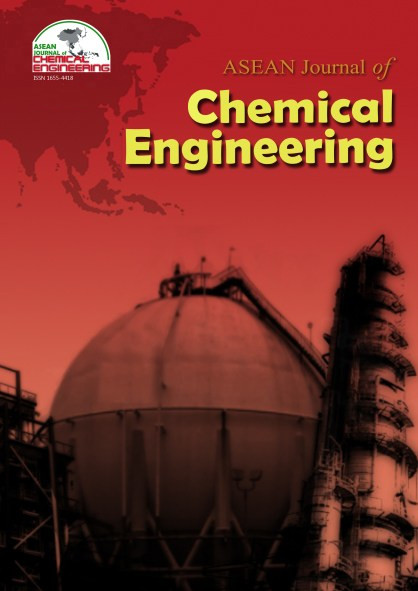Stability and Emission Characteristics of Diesel-Ethanol-Coconut Methyl Ester Blends for the Diesel Engines
Abstract
The stability and emission characteristics of diesel-ethanol-coconut methyl ester (CME) blends were studied to determine the most suitable fuel blends to be applied in diesel engines. This is done in order to assess the potential of the blends as a substitute for commercially available diesel fuel used in diesel engine. The stability results of the blends using 100% and 99.5% ethanol purity showed that the fuel blends containing ethanol up to 10% and CME of 5% and greater exhibited high mutual solubility at any temperature range and were resistant to microbial growths after 3 months storage. Engine operations at low speed especially at idle-no load and using a bigger size engine lead to a minimum ignition delay and result in lower fuel consumption rate. The emission test results with the new- blended fuels showed a reduction in CO2 and increasing percentage by volume of CO2 compared to commercially available diesel. The blends could deliver an efficient combustion and could run efficiently since production of the CO2 gases is higher than that of CO. The blends of 80% diesel, 5% ethanol, 10% CME; and 80% diesel, 10% ethanol, 10% CME could reduce the smoke opacity compared to commercially available diesel.
References
2. Cheenkachorn, K. Narasingha, M. H. Papakornnopaut, J.; “Biodisel as an Additive for Diesohol”, Asian journal on Energy and Environment, Vol. 7, No.01, pp. 267 -276 (2006)
3. De Caro, P. S. Moulongui, Z. Vaitilingom, G. Berge J.Ch.; “Interest of Combining an Additive with Diesel– Ethanol Blends for Use in Diesel Engines”, Fuel, Vol. 80, pp. 565–574 (2001)
4. Fernando, S., Hanna, M.; “Development of a Noval Biofuel Blend Using Ethanol- Biodiesel-Diesel Microemulsions: EB- Diesel,” Energy Fuel, Vol. 18, pp. 1685- 1703 (2004)
5. Kim, H. Choi, B.; “The Effect of Biodiesel and Bioethanol Blended Diesel Fuel on Nanoparticles and Exhaust Emissions from CRDI Diesel Engine”, Renewable energy, Vol. 35, pp. 157–163 (2010)
6. Kwanchareon, P. Luengnaruemitchai, A. Jai-In, S.; “Solubility of a Diesel– Biodiesel–Ethanol Blend, Its Fuel Properties, and Its Emission Characteristics from Diesel Engine”, Fuel, Vol. 86, pp. 1053 – 1061 (2007)
7. Pang, X. Shi, X. Mu, Y. He, H. Shuai, S. Chen, H. Li, R.; “Characteristics of Carbonyl Compounds From a Diesel Engine Using Biodiesel–Ethanol–Diesel as Fuel”, Atmospheric Environment, Vol. 40, pp. 7057–7065 (2006)
8. Qi, D. H., Chen, H., Geng, L. M., Bian, Y. Z.; “Effect of Diethyl Ether and Ethanol Additives on The Combustion and Emission Characteristics of Biodiesel- Diesel Blended Fuel Engine”, Renewable Energy, Vol. 36, pp. 1252-1258 (2011)
9. Rahimi, H. Ghobadian, B. Yusaf, T. Najafi, G. Khatamifar, M.; “Diesterol: An Environment-Friendly IC Engine Fuel”, Renewable Energy, Vol. 34, pp. 335–342 (2009)
10. Randazzo, M. L., Sodré, J. R.; “Cold Start and Fuel Consumption of a Vehicle Fuelled with Blends of Diesel Oil– Soybean Biodiesel–Ethanol”, Fuel, Vol. 90, pp. 3291–3294 (2011)
11. Singh, J. Mishra, T. N. Bhattacharya, T. K. Singh, M. P.; “Emission Characteristics of Methyl Ester of Rice Bran Oil as Fuel in Compression Ignition Engine”, World Academy of Science, Engineering and Technology, Vol. 3, No.6, pp. 198-202 (2007)
12. Subbaiah, G. V. Gopal, K. R. Hussain, S. A. Prasad, B. D. K. Reddy, K. T.; “Rice Bran Oil as an Additive for Diesel- Ethanol Blends for Diesel Engines”, International Journal of Research and Reviews in Applied Sciences, Vol. 3, No. 3, pp. 334-342 (2010)
13. Venkanna, B.K. Venkataramana, C. Reddy. Swati, B. Wadawadagi.; “Performance, Emission and Combustion Characteristics of Direct Injection Diesel Engine Running on Rice Bran Oil/ Diesel Fuel Blend”, International Journal of Chemical and Biomolecular Engineering, Vol. 2, No. 3, pp. 131-137 (2009)
14. Yilmaz, N.; “Comparative Analysis of Biodiesel-Ethanol-Diesel and Biodiesel- Methanol-Diesel Blends in a Diesel Engine”, Energy, Vol. 40, pp. 210-213 (2012)
Copyright holder for articles is ASEAN Journal of Chemical Engineering. Articles published in ASEAN J. Chem. Eng. are distributed under a Creative Commons Attribution-NonCommercial 4.0 International (CC BY-NC 4.0) license.
Authors agree to transfer all copyright rights in and to the above work to the ASEAN Journal of Chemical Engineering Editorial Board so that the Editorial Board shall have the right to publish the work for non-profit use in any media or form. In return, authors retain: (1) all proprietary rights other than copyright; (2) re-use of all or part of the above paper in their other work; (3) right to reproduce or authorize others to reproduce the above paper for authors’ personal use or for company use if the source and the journal copyright notice is indicated, and if the reproduction is not made for the purpose of sale.



